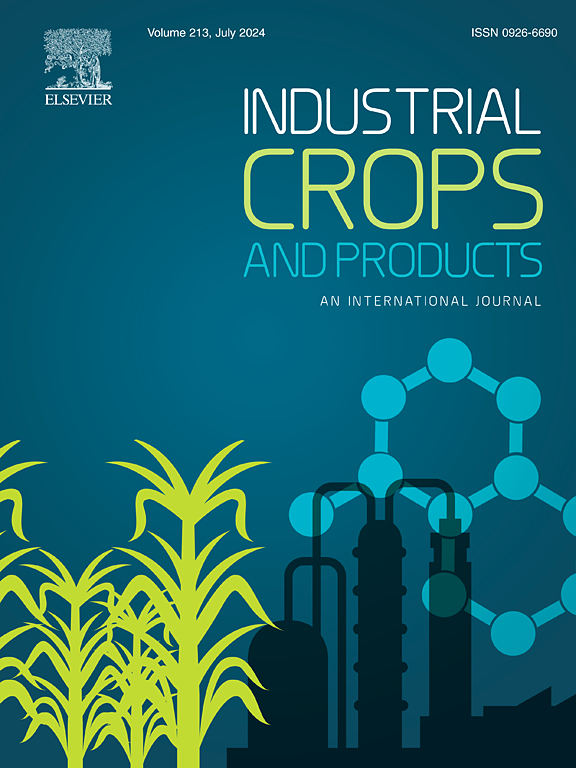Polysaccharides from Ulva prolifera promote tobacco plant growth by benefiting rhizosphere bacterial community in acidic soil
IF 5.6
1区 农林科学
Q1 AGRICULTURAL ENGINEERING
引用次数: 0
Abstract
The application of biostimulants is an effective strategy to enhancing plant growth and bolstering stress resilience. However, our understanding of the effects of polysaccharides from Ulva prolifera (PUP) on plant growth under abiotic stress remains limited. In this study, the effects of 100 mg/L (PUP-1), 300 mg/L (PUP-3), 500 mg/L (PUP-5) of PUP and water (CK) on the tobacco (Nicotiana tabacum L.) seedling growth in the acidic soil were compared by a microcosm experiment. The results indicated that PUP-1, PUP-3, and PUP-5 significantly increased the fresh weight by 24 %-70 %, respectively, potentially due to elevated levels of carotenoid, chlorophyll a, and chlorophyll b. PUP significantly improved properties and fertility of the acidic soil, such as pH, available potassium (S-AK), available phosphorus (S-AP), sucrase (S-SU), total nitrogen (S-TN), urease (S-UR), and acid phosphatase (S-APA). The abundances of some beneficial bacteria (Gemmatimonadaceae, Bacillus and Nitrospira) were enhanced by PUP-3 treatment, which might be associated with the increased pH and nutritional status of the soil. Moreover, the increase in the abundance of functional genes in biosynthesis pathways of carbon metabolism, amino acids, secondary metabolites, and fatty acids also demonstrated the positive effect of PUP amendments. Among them, PUP-3 (300 mg/L) treatment significantly promoted tobacco growth and optimized soil microbial composition, while higher concentrations (PUP-5) did not show further gains. In summary, the applications of PUP showed great potentials in the enhancement of plant growth in the acidic soil, and 300 mg/L is the optimal application concentration of this polysaccharide preparation in tobacco cultivation.

在酸性土壤中,增生Ulva多糖有利于根际细菌群落,从而促进烟草植株生长
生物刺激素的应用是促进植物生长和增强抗逆性的有效策略。然而,我们对增生Ulva多糖(PUP)对非生物胁迫下植物生长的影响的了解仍然有限。本研究通过微观环境试验,比较了100 mg/L (PUP-1)、300 mg/L (PUP-3)、500 mg/L (PUP-5)和CK对酸性土壤中烟草幼苗生长的影响。结果表明,PUP-1、PUP-3和PUP-5分别显著提高了24 %-70 %的鲜重,这可能是由于提高了类胡萝卜素、叶绿素a和叶绿素b的水平。PUP显著改善了酸性土壤的特性和肥力,如pH、速效钾(S-AK)、速效磷(S-AP)、蔗糖酶(S-SU)、总氮(S-TN)、脲酶(S-UR)和酸性磷酸酶(S-APA)。PUP-3处理提高了部分有益菌(芽孢杆菌科、芽孢杆菌科和硝化螺旋菌科)的丰度,这可能与土壤pH和营养状况的改善有关。此外,碳代谢、氨基酸、次级代谢物和脂肪酸等生物合成途径中功能基因丰度的增加也证明了PUP修正的积极作用。其中,PUP-3(300 mg/L)处理显著促进了烟草生长,并优化了土壤微生物组成,而更高浓度(PUP-5)处理则没有进一步的促进作用。综上所述,PUP在酸性土壤中促进植物生长方面具有很大的应用潜力,300 mg/L为该多糖制剂在烟草种植中的最佳施用浓度。
本文章由计算机程序翻译,如有差异,请以英文原文为准。
求助全文
约1分钟内获得全文
求助全文
来源期刊

Industrial Crops and Products
农林科学-农业工程
CiteScore
9.50
自引率
8.50%
发文量
1518
审稿时长
43 days
期刊介绍:
Industrial Crops and Products is an International Journal publishing academic and industrial research on industrial (defined as non-food/non-feed) crops and products. Papers concern both crop-oriented and bio-based materials from crops-oriented research, and should be of interest to an international audience, hypothesis driven, and where comparisons are made statistics performed.
 求助内容:
求助内容: 应助结果提醒方式:
应助结果提醒方式:


